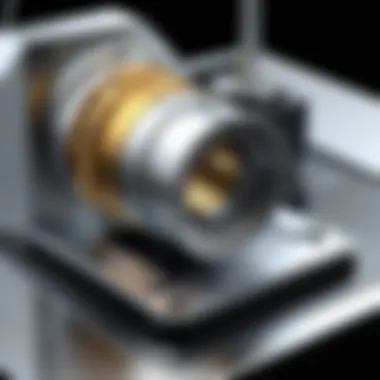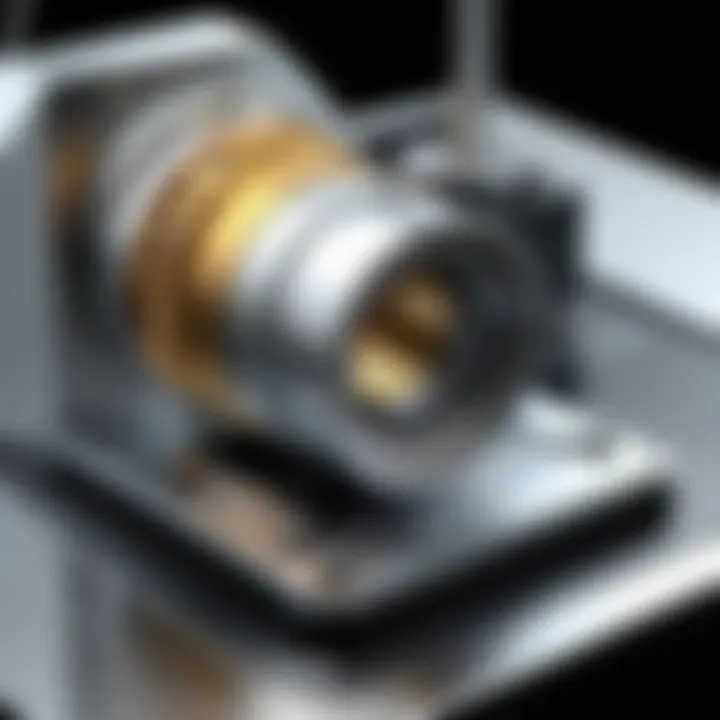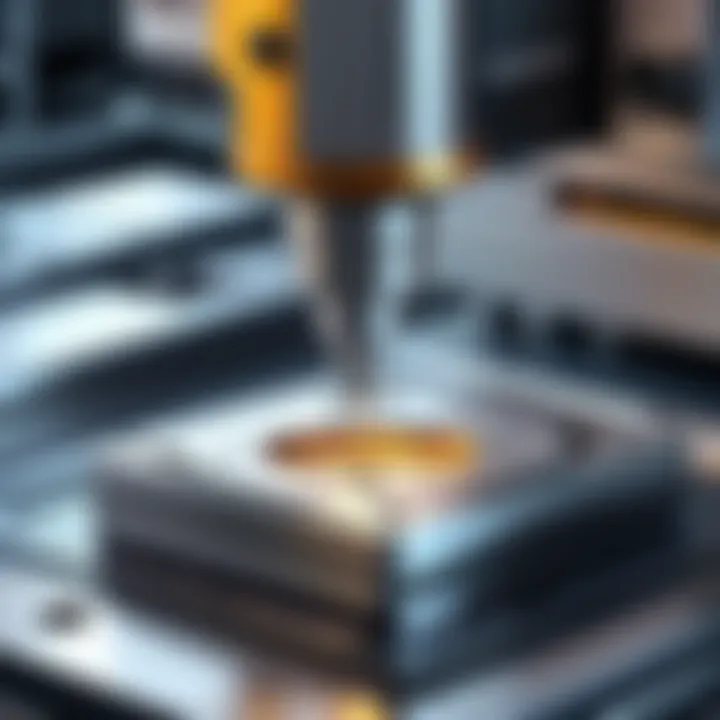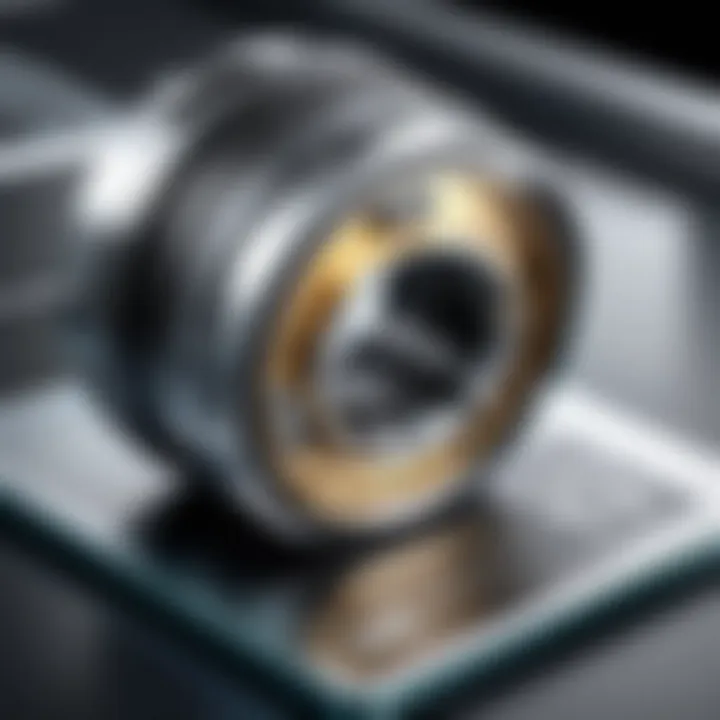CAD CAM Machining: Transforming Modern Manufacturing


Intro
In the realm of modern manufacturing, few advancements have made as substantial an impact as CAD CAM machining. This technology intertwines computer-aided design (CAD) and computer-aided manufacturing (CAM) to create a seamless workflow that enhances productivity and precision across various industries. The confluence of these technologies not only streamlines the manufacturing process but also opens doors to innovative practices that have the potential to redefine production standards.
Manufacturers are increasingly seeking solutions that improve efficiency while maintaining high-quality output. As we delve into the intricacies of CAD CAM machining, we will uncover how these systems serve as pivotal tools in achieving these goals. This guide aims to demystify the core principles behind CAD CAM, its functionalities, and its broader implications in the manufacturing landscape.
From small shops to sprawling factories, the integration of CAD CAM technology is reshaping how products are designed and manufactured. Understanding these systems is essential for IT and software professionals, as well as business leaders aiming to harness this technology for competitive advantage.
Throughout this article, we will cover everything from basic software overviews to the complexities of hardware requirements, ensuring that readers are equipped with the knowledge needed to make informed decisions in this evolving field.
Prelude to CAD CAM Machining
In the realm of modern manufacturing, CAD CAM machining stands as a crucial pillar, intertwining design and production like a well-crafted tapestry. Whether you’re running a small workshop or managing a large manufacturing enterprise, embracing this technology can significantly transform your operations. The blending of computer-aided design (CAD) with computer-aided manufacturing (CAM) has led to enhanced precision and efficiency, opening up new avenues for innovation and creativity.
Defining CAD and CAM
To grasp the impact of CAD CAM machining, it’s essential to define these two critical components. CAD refers to the use of software to create detailed drawings and models of products before they are fabricated. Imagine sketching out a concept for a new product on paper, only to realize that fitting it together isn’t as easy as you thought. With CAD, that conceptualization becomes a three-dimensional model, allowing engineers and designers to visualize every detail. This clarity prevents costly missteps down the line.
On the flip side, CAM takes those meticulous designs and brings them to life. It involves using software to control machinery in the manufacturing process. Consider it as a director who turns the screenplay into a movie; CAM software translates the CAD drawings into instructions that machines need to create the actual product. When both are employed together, the risks associated with production drop, while productivity skyrockets.
Historical Development of CNC Machining
Let’s step back in time a bit. The journey to today’s remarkable CAD CAM technology began in the mid-20th century. It was during this era that numerically controlled (NC) machines were developed. Initially, these machines operated using punched tape to conduct intricate operations in manufacturing. However, as technology evolved, so did the methods of control.
By the 1960s, CNC or computer numerical control machines were introduced, marking a pivotal shift. These machines integrated computers for precise control and programming, allowing for changes to be made swiftly, enhancing flexibility. Fast forward a few decades and CAD tools began dominating the scene, increasingly becoming sophisticated and user-friendly. Consequently, by the late 20th century, integrations of CAD and CAM systems transformed the industry landscape, facilitating a seamless workflow from design to production.
Today, the combination of CAD and CAM is more than just a convenience; it’s a necessity to keep pace with the ever-growing demands of the market. By embracing these advancements, manufacturers are not only able to keep their processes efficient but also stay competitive in a fast-paced environment. In the following sections, we will delve into key components of CAD CAM systems and uncover the workflow that makes it all possible.
Key Components of CAD CAM Systems
In the realm of modern manufacturing, the synergy between Computer-Aided Design (CAD) and Computer-Aided Manufacturing (CAM) is paramount. Understanding the key components of CAD CAM systems is like peering under the hood of a finely-tuned machine; it reveals the intricate workings that drive efficiency and precision in production. These systems don't just enhance productivity; they reshuffle the way businesses approach design and fabrication.
Software Tools and Platforms
Overview of CAD Software
CAD software plays a vital role in drafting, modeling, and visualizing designs before they enter the production phase. The integration of intuitive features like parametric modeling stands out, empowering designers to alter projects dynamically without starting from scratch. This characteristic elevates CAD to a preferred choice among professionals aiming for both efficiency and creativity in design processes.
A prominent example is Autodesk AutoCAD, with its flexibility allowing designers to create detailed schematics and 3D models. The software's ability to generate comprehensive drawing sets contributes to its appeal across various industries. However, one should be aware of its steep learning curve, which can be intimidating for beginners.
Overview of CAM Software
On the flip side, CAM software translates those designs into machine language, facilitating the actual manufacturing process. It significantly simplifies complex toolpath creation and resource planning, ensuring that the machinery executes cuts with pinpoint accuracy. Notable software in this segment includes Mastercam, renowned for its robust toolpath generation features.
CAM software is beneficial mainly due to its capacity to minimize human error, streamlining production workflows to achieve consistent outputs. Yet, users must consider its dependency on high-quality model inputs from CAD, as the output’s quality is only as good as the design quality.
Integration of CAD and CAM Systems
The integration of CAD and CAM systems bridges the gap between design and manufacturing. With the right tools, this collaboration fosters a seamless workflow—eliminating redundancy and aligning design intent with manufacturing capabilities. One highly advantageous aspect is the ability to instantly update designs in response to production requirements. This dynamic adaptability leads to better project timelines and cost savings.
A standout feature is the ability to share data between systems via a unified platform, which also allows for collaborative modifications. Despite its broad benefits, one must challenge integration with potential compatibility issues, particularly when using different software brands or versions, which can lead to data loss or miscommunication.
Hardware Requirements
Computers and Workstations


To run CAD CAM systems effectively, robust hardware is a must. Computers and workstations must accommodate demanding graphics and processing tasks without a hitch. A significant factor involves the specifications, such as high RAM and advanced graphics card capabilities that facilitate smoother operations when handling large datasets.
Choosing a workstation such as those offered by Dell or HP, which are generally optimized for design software, often proves beneficial. However, a higher initial investment is required, which might swing a decision for smaller businesses.
Machining Equipment
Beyond computers, the right machining equipment is essential for executing the plans created in the software. CNC (Computer Numerical Control) machines are the backbone of CAM manufacturing, translating digital designs into tangible products with unmatched precision.
Key characteristics involve broad versatility; a modern CNC machine can handle various materials, from metals to plastics. The downside, though, rests in both the maintenance and operational costs, as well as the skills needed for effective usage, demanding trained personnel to maximize productivity.
In sum, each component of the CAD CAM systems contributes to a landscape of enhanced functionality and efficiency in modern manufacturing, laying the groundwork for ongoing developments in technology.
The CAD CAM Workflow
The importance of the CAD CAM workflow cannot be overstated in the context of modern manufacturing. This workflow serves as the backbone of turning concepts into tangible products. It begins with the initial design phase and flows seamlessly into production, making it a pivotal part of the overall CAD CAM system. Each step in this workflow is interlinked, allowing for a streamlined approach that maximizes efficiency, minimizes errors, and enhances overall productivity.
By understanding the CAD CAM workflow, businesses can identify bottlenecks, optimize processes, and ultimately deliver better products faster.
From Design to Production
CAD Design Process
The CAD design process is often regarded as a critical phase in the workflow. It involves creating detailed 3D models of products using specialized software like AutoCAD or SolidWorks. One key characteristic of the CAD design process is its user-friendly interface, which allows designers to visualize complex geometries in a straightforward manner. This visual representation leads to better communication among team members, clients, and stakeholders.
One unique feature of this process is the ability to quickly iterate designs, allowing for rapid prototyping. This capability proves beneficial since designers can make adjustments based on feedback without significant time loss. However, the potential downside lies in the reliance on software tools. A designer's proficiency with the CAD software can greatly affect the quality of the final product.
CAM Programming
CAM programming is where the rubber meets the road in CAD CAM workflows. This aspect entails converting the CAD designs into machine language that manufacturing equipment can understand. A hallmark of CAM programming is its precision; it helps ensure that machines produce parts that match the specifications set in the CAD models.
A significant advantage of CAM programming is its automation capability, which can significantly reduce human error. The unique feature here is the use of toolpath optimization, which fine-tunes the machining process for enhanced efficiency and reduced material waste. However, the downside could be the complexity of programming for intricate designs, which may require highly skilled personnel to navigate the challenges.
Quality Control and Testing
Quality control is the safety net that manufacturers rely on to maintain standards throughout the production process. Implementing robust quality assurance techniques is essential to ensure that every part produced meets the required specs.
Techniques for Quality Assurance
Techniques for quality assurance often incorporate statistical methods and manual inspections to catch defects before products reach their final destination. A distinctive quality of these techniques is the data-driven approach, which allows companies to identify trends over time and adjust processes accordingly.
These methods must be accurate, and frequent checks improve the overall reliability of the products. Yet, the trade-off here is the time involved in manual inspection processes, which can slow down production, especially for larger batches.
The Role of Prototyping
Prototyping plays a pivotal role in bridging the gap between design and manufacturing. Its fundamental purpose is to test the viability of a design before final production. The key feature of prototyping is that it allows for mistakes to be identified early in the process. By creating a physical model, designers can evaluate the feasibility and functionality of the design, which can save time and resources in the longer run.
The main advantage of using prototypes is that they foster innovation. Testing different versions can lead to enhanced product design. However, it should be noted that prototyping might involve additional costs and resources that some companies may find a burden.
"The CAD CAM workflow is not just a series of steps; it's the essence of modern manufacturing, harmonizing design with production seamlessly."
Understanding each facet of the CAD CAM workflow enables professionals to pinpoint strengths and weaknesses in their processes, paving the way for enhanced productivity and innovative designs. Effective navigation through this workflow leads to better quality products that meet the ever-evolving demands of the market.
Applications of CAD CAM Machining
The applications of CAD CAM machining have reshaped modern manufacturing processes, offering a multitude of benefits across various sectors. This technology is not just a tool but a foundation upon which industries build their efficiency, precision, and innovation. As factories become more automated and the demand for higher quality products increases, understanding how CAD CAM integrates into everyday operations is crucial. It allows industries to streamline production, minimize waste, and enhance the overall quality of their output.
Industries Utilizing CAD CAM


Aerospace
In the aerospace industry, the role of CAD CAM is paramount. Machining high-precision parts such as turbine blades and fuselage components demands extraordinary accuracy. Here, CAD CAM facilitates meticulous design and manufacturing processes, ensuring that every component meets the rigorous standards set by regulatory bodies. The key characteristic of aerospace applications is the critical need for weight reduction without compromising strength. This makes CAD CAM an invaluable ally, allowing engineers to design components that are lightweight yet robust. However, the unique feature lies in the potential complexity of aerospace components which can lead to longer development times and higher costs. Still, the long-term advantages – notably increased safety and efficiency – far outweigh the initial challenges.
Automotive
The automotive sector relies heavily on CAD CAM as well. This industry is characterized by its drive for speed and efficiency in production, which is where CAD CAM shines. The technology enables automakers to rapidly design, prototype, and manufacture parts. Notably, it allows for the mass production of intricate components like engine housings and chassis parts. The beneficial aspect here is the reduced time from design to market, directly influencing profit margins. A unique feature of automotive applications is the fine-tuning of designs for fuel efficiency and performance. However, the frequent shifts in consumer preferences and regulatory compliance can pose challenges to manufacturing adaptability.
Medical Devices
In the realm of medical devices, precision is a matter of life and death, making CAD CAM integration critical. From prosthetics to surgical instruments, the tailored solutions provided by CAD CAM significantly enhance product reliability. The key characteristic of this sector is customization; each device often needs to be tailored to individual patient requirements. Thanks to CAD CAM's adaptability, manufacturers can create complex shapes and geometries that traditional machining methods struggle to achieve. One unique feature of medical device manufacturing is the extensive validation and testing involved, which can extend lead times but ultimately results in superior products. The trade-off between development speed and regulatory approval is a pivotal consideration for manufacturers aiming to enter the market efficiently.
Case Studies of Successful Implementation
Small Enterprises
Small enterprises leverage CAD CAM to compete with larger firms by enhancing operational capabilities. For instance, a small custom furniture maker may utilize this technology to create unique designs quickly and reduce material waste. The key characterization here is agility in adapting to customer demands. CAD CAM allows these businesses to prototype designs swiftly, significantly boosting their productivity. However, the unique feature also includes potential scalability challenges. While CAD CAM offers immediate advantages, small enterprises must invest in technology and skill development to maximize its benefits fully.
Large Manufacturing Firms
Large manufacturing firms exemplify the efficiency of CAD CAM on a grand scale. These companies often have the resources to implement sophisticated CAD CAM systems, leading to total integration across various departments. Take, for example, a major electronics manufacturer that uses CAD CAM in product design, tooling, and production. The key characteristic is the optimization of production lines, which reduces downtime and improves throughput. Despite significant advantages, these firms also face challenges such as the necessity for constant updates and maintenance of their technology, alongside handling vast amounts of data from numerous machines. The complex integration of diverse systems can add layers of complexity but ultimately drives innovation.
"In the modern era of manufacturing, CAD CAM is not just a tool; it's a strategic asset that shapes how products are designed and produced across industries."
Advantages of CAD CAM Machining
In the intricate world of modern manufacturing, understanding the advantages of CAD CAM machining is key for businesses aiming to enhance their operational efficiency and product quality. These systems do not merely serve to automate processes; they encapsulate a philosophy of design and production that fundamentally alters how products are crafted. In this section, I'll detail how integrating CAD and CAM can lead to significant improvements across various aspects of manufacturing, focusing specifically on increased precision and accuracy as well as enhanced production speed.
Increased Precision and Accuracy
CAD CAM systems provide an unparalleled level of precision that is often unattainable through traditional manufacturing practices. When artisans handcraft items, variables such as human error, environmental factors, and mechanical inconsistencies can lead to imperfections. However, with CAD applications like Autodesk Inventor or SolidWorks, designers can create digital models that are meticulously detailed. Once the design is solidified, CAM software like Mastercam translates these into precise machining instructions.
- Computer numeric control (CNC) machines, like those from Haas Automation or DMG Mori, execute these instructions with exacting standards. This reduces the likelihood of defects drastically.
- The integration of simulation software allows manufacturers to not only visualize the finished product but also to identify any potential issues before the actual manufacturing begins. This capability minimizes costly mistakes and enhances product integrity.
With CAD CAM technology, companies report a noticeable decrease in scrap rates due to these precise manufacturing techniques. As a result, business operations become more cost-effective, improving the overall bottom line.
"Precision is the soul of efficiency."
Enhanced Production Speed
Another pivotal benefit of CAD CAM machining is the remarkable enhancement in production speed. Traditional methods often require various intermediate steps—design, prototyping, workshop discussions, and revisions. Each stage consumes both time and resources. With CAD CAM, businesses can streamline these processes.
- The automatic translation of design into manufacturing instructions means that once a design is approved, production can commence almost immediately. This leads to faster turnaround times, which is crucial for industries requiring quick responses to market demands.
- Additionally, using advanced machining solutions like 5-axis CNC machines, manufacturers can perform multiple machining operations in a single setup. This not only saves time during production but also reduces the potential for errors related to re-fixturing.
Faster production not only means higher output but also enables companies to respond quickly to changes in consumer preferences or the market landscape. As a result, organizations that implement CAD CAM technology can achieve a competitive edge, keeping them ahead of the curve in a fast-paced industry.
In summary, the advantages of CAD CAM machining are profound. With increased precision, reduced waste, and accelerated production processes, businesses can thrive in an environment where efficiency and quality are paramount.
Challenges and Limitations
While CAD CAM machining proudly stands at the forefront of modern manufacturing, it's important to note that it does not come without its share of hurdles. In this section, we'll discuss the challenges and limitations that accompany the adoption and implementation of these systems in various industries. Understanding these factors is crucial for businesses aiming to fully leverage the potential of CAD CAM technology.
Initial Costs of CAD CAM Implementation
The financial implications of starting a CAD CAM system can be daunting. From the software licenses to hardware upgrades and training expenses, the initial costs can add up quickly. Companies may feel like they're about to sail into treacherous waters when they see the price tag attached to quality CAD CAM tools.


Starting out, companies often grapple with:
- Software Licenses: High-quality software isn't cheap. Secure licenses for industry-standard CAD and CAM software often require substantial investment upfront.
- Hardware Upgrades: Many times, existing machinery may not be suitable for integration with CAD CAM technologies. This might involve purchasing new machines or retrofitting older ones.
- Training and Skill Development: Depending on the sophistication of the tools, training employees to use the software can further strain budgets. Given that every dollar counts, this can give businesses pause on whether the investment is justified.
These costs can deter smaller businesses or startups from diving into the CAD CAM pool. However, careful planning and budgeting can mitigate some of these burdens; considering it as a long-term investment in productivity may just offset those expenses down the line.
Learning Curve and Skill Development
Transitioning to CAD CAM systems is not just about having the right tools; it also entails a significant learning curve. Employees who are accustomed to traditional manufacturing techniques may find themselves at a fork in the road. The challenge lies in bridging the gap between traditional skills and new technology. This shift isn't always as seamless as one would hope.
Key points to consider include:
- Training Needs: As mentioned earlier, training is essential. Before employees can unlock the full potential of CAD CAM, they must understand how to navigate the software and machinery effectively.
- Time to Adapt: The time it takes for teams to become proficient can vary widely. This means that companies may face temporary dips in productivity until their workforce comes up to speed.
- Continual Development: Given that technology evolves rapidly, continuous education becomes necessary. Employees must stay updated with new features or software updates. This can be resource-intensive and may require dedicated time away from production work.
Ultimately, the integration of CAD CAM technology is a balancing act between capitalizing on innovation and ensuring that staff are adequately prepared to handle the new tools. With proper planning and a mindset geared toward growth, the transition can lead to substantial rewards in efficiency and production capabilities.
Future Trends in CAD CAM Machining
The landscape of manufacturing is constantly evolving, and CAD CAM machining is no exception. In recent years, several trends have begun to shape the future of this industry. It's important to keep an eye on these trends to not only maintain competitiveness but also to align with the shift towards modernization. Companies that adapt early can leverage the latest advancements for better efficiency and product development. Today, we look at two pivotal areas driving change: technology innovations and sustainability.
Innovations in Technology
Artificial Intelligence
Artificial intelligence (AI) stands as a transformative force in CAD CAM machining. This technology empowers users to improve design and production processes in ways previously thought impossible. AI algorithms analyze vast amounts of data—helping to predict equipment failures, optimize machining paths, and even enhance the design phase by suggesting improvements. Because of its ability to learn and adapt, AI offers a degree of automation that can significantly cut down manual intervention.
One key characteristic of AI is its capacity for predictive analytics. It uses historical manufacturing data to foresee potential issues and suggest solutions even before problems arise. This proactive approach greatly reduces downtime and improves operational efficiency. For organizations focusing on precision and minimal tolerance levels, AI is not merely an option but a necessity.
However, while AI holds extraordinary benefits, implementing it can prove challenging. Businesses may face the complexity of integrating AI systems with existing machinery, which can be costly and time-consuming. Additionally, there could also be resistance from employees who might be concerned about machines taking over their jobs. Overall, AI represents a paradigm shift that promises substantial rewards for those who can navigate its intricacies.
Internet of Things Integration
The advent of the Internet of Things (IoT) adds another layer of sophistication to CAD CAM machining. IoT enables interconnected devices to communicate and share data, providing real-time insights into production processes. Sensors embedded in machinery send information regarding operational performance and maintenance needs, allowing for real-time monitoring and adjustments.
One of the main attractions of IoT is its ability to enhance overall equipment effectiveness (OEE). By analyzing data from various devices, manufacturers can pinpoint inefficiencies, reduce waste, and streamline workflows. This connectivity means that manufacturers today can make informed decisions quickly, adapting to changes in demand or unexpected variances in production.
Yet, alongside its benefits, there are hurdles as well. Security is a prominent concern, as more connected devices open new avenues for cyber threats. Additionally, the abundance of data can overwhelm decision-makers if they lack systems to analyze and interpret it effectively. Despite these risks, IoT integration is crucial for staying ahead in a fast-moving industry.
Sustainability and Environmental Impact
As industries around the globe face increasing scrutiny on environmental issues, the role of sustainability in CAD CAM machining cannot be overstated. Manufacturers are now exploring eco-friendly methods and materials—addressing not just regulatory pressures, but also consumer demand for sustainable practices.
Consider practices such as waste minimization and energy efficiency. CAD CAM systems can be programmed to optimize material usage, generating less scrap during the machining phase. By simulating the design process, engineers can recycle designs to minimize waste before they ever hit the shop floor. Furthermore, energy-efficient machinery and smart power management systems can drastically reduce a company's carbon footprint.
The move toward sustainability is not just a trend; it’s a new business imperative. Companies that prioritize sustainable practices often see enhanced brand loyalty and customer satisfaction. To sum it up, as technology and environmental awareness advance, CAD CAM machining will increasingly align with initiatives aimed at reducing negative ecological impacts.
"Companies that adapt early can leverage the latest advancements for better efficiency and product development."
End
The Importance of CAD CAM in Modern Manufacturing
In today’s fast-paced world of manufacturing, CAD CAM technologies have transformed the landscape in ways that were unimaginable just a few decades ago. The integration of computer-aided design and computer-aided manufacturing facilitates a seamless workflow that enhances precision and consistency, while reducing lead times. It’s not just about making shapes; it’s about creating them with a level of accuracy that ensures the end product is exactly what the design intended. This precision minimizes waste and errors, saving both time and resources, which is integral for businesses looking to thrive.
Moreover, CAD CAM systems allow for rapid prototyping, enabling companies to test ideas and concepts without a significant investment in resources. In industries like aerospace, automotive, and medical devices, the ability to quickly iterate designs can be the difference between leading the market or falling behind.
Final Thoughts on Future Developments
As we gaze into the horizon of manufacturing technology, it’s clear that the future of CAD CAM will be marked by rapid innovation. Emerging technologies such as artificial intelligence and machine learning are beginning to intertwine with CAD CAM systems, offering capabilities that promise to elevate these tools to new heights. For instance, AI could automate routine tasks or even suggest design modifications based on historical data and ongoing trends, allowing designers and engineers to focus on more complex problem-solving aspects.
Furthermore, the integration of the Internet of Things (IoT) heralds a new era where machines not only produce but also communicate, sharing real-time data on performance and maintenance needs. This could revolutionize how factories operate, turning them into smart environments where optimization and efficiency are constantly monitored and improved.
Ultimately, embracing these advancements isn't simply a matter of keeping pace with competitors; it’s about harnessing these powerful tools to create a manufacturing ecosystem that’s flexible, responsive, and sustainable. The journey of CAD CAM is just beginning, and those who invest in understanding and applying these principles are bound to reap the benefits for many years to come.



